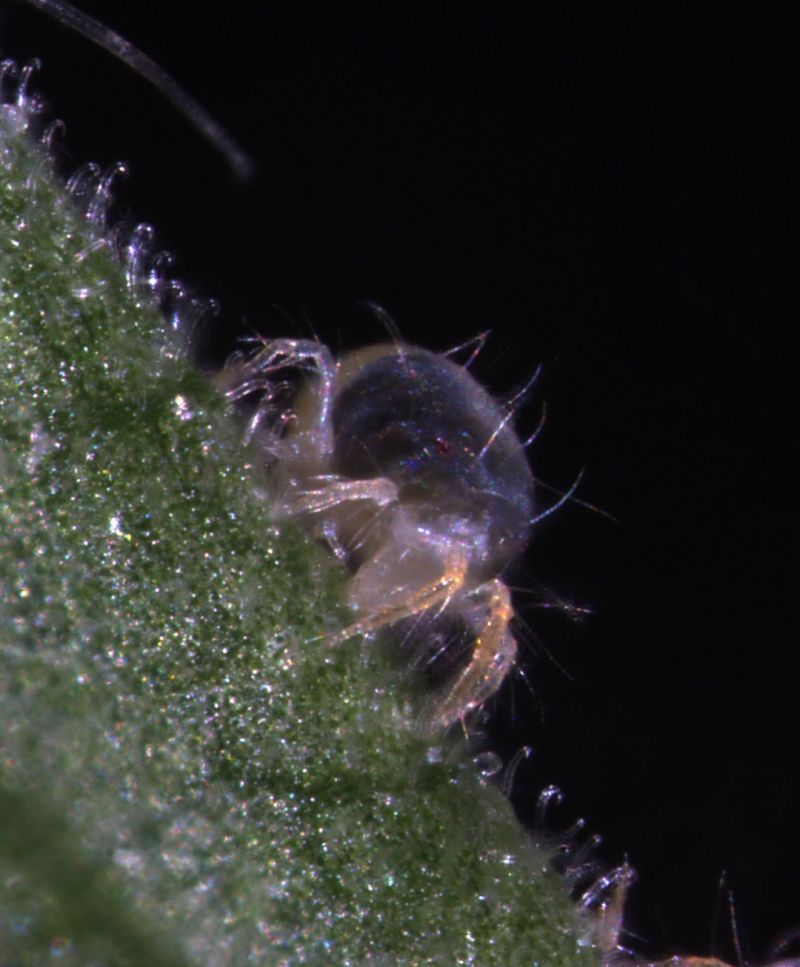CBGP researchers participate in sequence genome of spider mite
The spider mite, Tetranychus urticae, feeds on more than 1,100 plant species belonging to more than 140 different plant families including species known to produce toxic compounds. It is a major pest in greenhouse production and field crops, destroying annual and perennial crops such as tomatoes, peppers, cucumbers, strawberries, maize, soy, apples, grapes and citrus.
The spider mite is known for its ability to develop rapid resistance to pesticides. Among arthropods it has the highest incidence of pesticide resistance. Many aspects of the biology of the spider mite, including rapid development, high fecundity and haplo-diploid sex determination, seem to facilitate rapid evolution of pesticide
 This work has been developed by an international consortium led by Dr. Miodrag Grbic, Professor of the Western Ontario University (Canada) and currently joined to the Instituto de Ciencias de la Vid y el Vino (CSIC-Logroño). The consortium includes scientists from more than 30 institutions from different countries. The results has been published in the international weekly journal of Science Nature
This work has been developed by an international consortium led by Dr. Miodrag Grbic, Professor of the Western Ontario University (Canada) and currently joined to the Instituto de Ciencias de la Vid y el Vino (CSIC-Logroño). The consortium includes scientists from more than 30 institutions from different countries. The results has been published in the international weekly journal of Science Nature
The researchers present the completely sequenced and annotated spider mite genome, representing the first complete chelicerate genome. Deep transcriptome analysis of mites feeding on different plants shows how this pest responds to a changing host environment. The T. urticae genome thus offers new insights into arthropod evolution and plant–herbivore interactions, and provides unique opportunities for developing novel plant protection strategies.
UPM Participation
The research groups of Drs. Isabel Díaz and Manuel Martínez (Centro de Biotecnología y Genómica de Plantas UPM-INIA), Felix Ortego and Pedro Hernández (Centro de Investigaciones Biológicas, CSIC-Madrid) and Vojislava Grbic (Visitant Professor of the European Marie Ciencias de la Vid y el Vino, CSIC-Logroño) have uncovered the genetic basis of the ability of mites to feed on many different plants.
The spider mite is able to multiply and differentiate new genes to overcome the defense mechanisms of plants. What is more surprising, this species integrate in its genome several genes responsible for the process of detoxication from bacteria, fungi or even plants that allow to combat the defense response of plants. Detoxification is the ability of the spider mite to resist and overcome the toxins used by plants to defend themselves from attack by spider.
The Universidad Politécnica de Madrid took part in this project together with the Centro de Investigaciones Biológicas (CIB-CSIC) and has dealt in unveiling the components of the digestive physiology of the spider mite which allow its poliphagous pattern of feeding and facilitates the adaptation to complete its life cycle on leaves from a wide range of plants, commented Isabel Díaz, scientist at the CBGP as well as Professor at the ETSI Agrónomos of the UPM. Additionally, the results from this work hare the key for increasing insights about the spider mite ability to feed on more than 1,100 plant species, and to develop new strategies of pest control that in a near future will reduce the use of conventional pesticides, concludes Dra. Diaz.
Silk for nano-materials
Even though the spider mite is an important and harmful pest, Grbics´s group, in collaboration with nano-physicists Marisela Velez (Universidad Autónoma de Madrid) found a novel beneficial feature of the spider mite, the spider mite silk. The silk produced by spider mites is a natural nano-material of extreme lightness that has potential uses as reinforcement in composite materials (for example, in the auto and aeronautic industries), nano-devices and nano-probes for investigating the function of the cell, and as a matrix for tissue engineering and drug delivery.
Source: UPM and NATURE Journal
Picture: Instituto de Ciencias de la Vid y del Vino -ICVV

